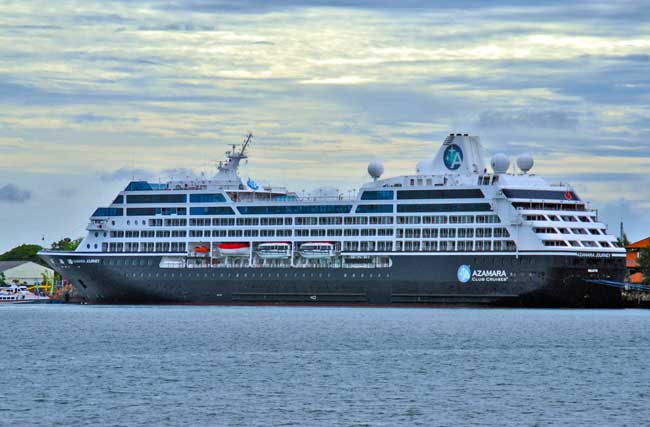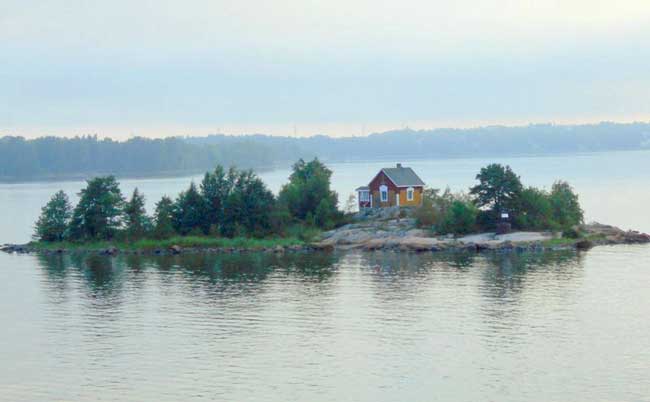

Aboard the Azamara Journey
Eight days had passed since we boarded the Azamara Journey, one of Royal Caribbean’s 600 passenger ‘small ships’ which departed from Leith, Scotland. The ring of picturesque canals circling Copenhagen, Denmark, the thrill of meeting the iconic Lech Walesa in Gdansk, Poland and a walking tour of the medieval capital of Tallinn, Estonia left us with indelible images.
But with the crowning glory of this 14-day cruise through the Baltic Sea at our next port-of-call, I felt like an impatient child, asking ‘Are we there yet?’
As the ship navigated through the Gulf of Finland, I stood on our veranda and fidgeted with binoculars, searching for the first sign of St. Petersburg, Russia. Ignoring the onslaught of recent US-based negative press about this country, a surge of excitement took over.

First Impressions of St. Petersburg, Russia
Through the dawn’s mist, a small mound of earth and rocks rose out of the water. Centered on the island, a tiny summer cottage, surrounded by sprouting fruit trees and a neatly furrowed vegetable garden emerged.
After the collapse of the USSR, Russian citizens had the opportunity to privatize these former family-owned retreats, called dachas. Now, many urban Russian families either rent or own one of these vacation properties to escape from the chaos of the city. Ever since Tsar Peter the Great started giving dachas as gifts to loyal staff, having a permanent ‘getaway’ became part of the Russian way of life.
Miles of commercial seaport activities, cranes unloading cargo and fuel depots cropped up along the banks as we glided toward St. Petersburg’s harbor. The Journey by-passed massive cruisers forced to tie-up far outside the city, while our captain maneuvered his smaller craft to the most enviable dock location in downtown St. Petersburg.
I encouraged my husband to share the magnificent view from our veranda. The gilded domes of the Russian Orthodox Church of Assumption of St. Mary glistened in the early morning sun.

He raced out, camera in hand and in his witty manner, yelled out, “I can see Russia from my stateroom!” Of course, unlike Sarah Palin, he really could.
Facing the Neva River, imposing 17th and 18th Century buildings shared the block with this five-domed place of worship. The ship’s marina berth placed us directly across from the tree-lined promenade that fronted the street. I paused for a few speechless moments to take in the enormity of our current position on the globe and the breadth of history before us.
Entranced by the Russian Orthodox Church of Assumption of St. Mary
We snapped photos of the church while the ship cleared Russian customs. I googled this forgotten St. Petersburg cathedral not included on major tours. I had to know about it.
Originally erected in 1730, the current building was reconstructed in 1895 with curved brick and mosaic tiles. Crossing arches inside the main dome provided a spacious interior and gleaming aluminum coated the cupolas.
The church functioned as a Russian Orthodox monastery until the monks were arrested by the government in 1932. It served as a warehouse until 1956, when the Communists converted it to the Leningrad School of Figure Skating.
USSR ice skating athletes trained at this facility and I remembered that in the late 60’s, Soviet champions dominated every Olympic skating event. That supremacy developed here. Returned to the Russian Orthodox in 1991, restoration to the church’s original splendor, revealing interior frescos hidden under layers of whitewash and oil paint, remains in progress.

crowds were moved along by security guards. Photo by Carol L. Bowman
Arriving in St. Petersburg
‘Visas Upon Entry’ for cruise ship passengers differ from individual travel permits obtained from a Russian Consulate. No one is allowed ashore without a pre-booked tour ticket and passport in hand. Every person leaving the ship must pass through immigration for inspection of these items. Wandering the streets of St. Petersburg without a tour guide who serves as a ‘minder’ is now forbidden.
Three full days in port, with two scheduled 10-hour tours allowed time to visit many of St. Petersburg’s historic sites. Jaws dropped at Peter the Great’s residence, Peterhof, Catherine the Great’s opulent Summer Palace in Pushkin and the meandering halls of the Hermitage Museum.
Thousands of summer tourists shuffled along the corridors of these magnificent structures. My experience of being swept along with the crowds, left me feeling detached.
At the Hermitage, I viewed Rembrandt’s Mother and Child in between taller heads bobbing. Security guards ordered the mob to ‘move along,’ crushing any hope of appreciating the art up-close.

I longed to experience the cultural capital of Russia that I had witnessed from the bus window; immaculate streets void of trash, sidewalks filled with on-the-go Russians and outdoor cafes brightened by petunia-filled flower boxes.
Schools of ballet, concert halls and opera houses lined wide boulevards that resembled the Upper Eastside of New York. Draw-bridges that crossed the Neva River connected the 14 islands that make up the city. I wanted to be part of the fabric. On day three, this American in love with St. Petersburg got her chance.
A Russian Tea Party
Rather than touring more buildings, 12 ship passengers opted to visit a Russian family’s home for tea. Our means of transportation? The Metro! Using a city’s subway system always makes me feel ‘like one of the locals.’

We met our ‘minder’ early upon exit from immigration. While she waited for the other guests, my husband, eager to bend the rules, begged her to let us stroll down to our coveted Church of Assumption, unaccompanied!
Young, neatly groomed and speaking flawless English, she eyed us cautiously then gave the go ahead.
“Well, okay, but promise to return in exactly 20 minutes so that we can proceed to the Metro.”
Like two little kids who had been allowed to stay up past bedtime, we skipped down the promenade toward the church. Seeing it up close and feeling the raised relief, my husband shouted, “We’re doing a forbidden thing.” He was ecstatic.
The Metro station displayed vestiges of the Soviet Era with plaques of hammer and sickle. Two sets of almost vertical escalators took us into the bowels of St. Petersburg. Graffiti-free walls, marble statues and art graced the interior.

We rode a vintage line with well-maintained cars packed with riders. I loved mingling with the people. They seemed no different than us. Struggling to get to work, to feed their families, to live their lives in peace.
Within 30 minutes, we stood in front of a modest apartment building where Natasha and Boris lived in a third-floor flat. I realized that years ago, Rocky and Bullwinkle cartoon characters had these same names.
The stairs seemed drab and dark, but a potted geranium in the window at level two gave the space life. Waiting to welcome us on the landing, Natasha held a squirming bull dog in her arms, while her young 4-year old daughter Marsha, peeked from behind her mother’s skirt.
Marsha said in English. “We’ve been waiting for you. Come in.”

Ushered into a cozy but crowded room, we took places at clothed tables set with unmatched antique tea cups and hand-painted porcelain dessert plates. Home-made marmalade and stacks of freshly griddled Russian blintzes graced each table.
I gave Marsha a woven pouch filled with caramels, both made in Mexico where I live. Eyes wide, she slid the purse strap over her head and danced back and forth, stroking her unique gift.
“She’s never had a bag or candy from Mexico before,” said Natasha. I asked about the family’s ability to speak English. “From pre-school on, English instruction is mandated,” Natasha said with pride.
A Russian Family’s Daily Life
The five-room flat provides housing for Natasha’s entire nuclear family. Each member or couple is assigned one room of the apartment. We happened to be having tea in a space which doubled as the bedroom of Marsha’s grandmother.
“During the Communist era, five different families occupied this one flat,” said Boris. “We are fortunate to now have it for our family alone.”
Both described the normal ups and downs of Russian life. Weekly activities swirl around Natasha’s job at an international hotel, Boris’ career at the local shipyard and the 10-year old son’s obsession with playing soccer. They struggle with mounting costs of everyday goods and high taxes.
I asked if they thought the United States and Russia would ever be allies rather than adversaries.
Boris suggested that there are two schools of thought on this subject − ‘perhaps and never.’ Their main concern is the family’s well-being, they only watch the news once a month, and they rarely discuss politics.
Natasha described the family’s sanctuary from every day issues − their weekend retreats at their dacha.
“It doesn’t have indoor plumbing or any amenities except electricity. We must bring everything that we need when we go, but it has given our family a connection with nature and a place to grow vegetables. We love it.”
I thought back to my first glimpse of Russia days ago. They commented on the one state policy they find hard to accept. In the winter, which comes swiftly around early October, the government controls the heat to these residential apartment buildings. There must be three consecutive days when the outside temperature falls below 8◦ C (46.4 ◦ F) before any warm steam flows.
“We wear a lot of coats,” said Natasha.

We affectionately embraced our new Russian friends at departure time. Ascending from the depths of the subway station, we surfaced at a bustling St. Petersburg Square. Larisa, our guide, saw the eagerness on her charges’ faces.
“Go, explore, feel the excitement of the street, take a picture with the statue of Dostoyevsky. Meet me here on the corner in 30 minutes,” she said. I rushed over to hug her.
- How to Renew a US Passport Quickly and Affordably - April 19, 2024
- 6 Reasons to Visit Portland, Maine (+ Travel Tips) - April 18, 2024
- Cruising with Discovery Princess on the Mexican Riviera - March 30, 2024
